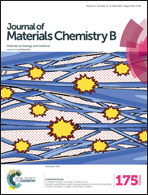Hybrid lanthanide nanoparticles as a new class of binary contrast agents for in vivo T1/T2 dual-weighted MRI and synergistic tumor diagnosis†
Abstract
Lanthanide nanoparticles (NPs), which are known as upconversion fluorescence probes for multimodal bioimaging, including magnetic resonance imaging (MRI), have attracted much attentions. In MRI, conventional contrast agents are generally employed separately in a single type of MRI. T1- and T2-weighted MRI alone have unique limitations; therefore, it is urgently necessary to combine the two modalities so as to be able to provide more comprehensive and synergistic diagnostic information than the single modality of MRI. Unfortunately, there is a lack of advanced materials as enhancing agents which are fully suitable for bimodal MRI. Here, we report a new class of hybrid lanthanide nanoparticles as synergistic contrast agents in T1/T2 dual-weighted MRI and imaging-directed tumor diagnosis. The r2/r1 value of BaGdF5 NPs can be readily adjusted from 2.8 to 334.8 by doping with 0%, 50%, or 100% Ln3+ (Ln3+ = Yb3+, Er3+, or Dy3+), respectively. Among these, BaGdF5:50% Er3+ NPs were successfully used as binary contrast agents for T1/T2 dual-weighted MRI and synergistic tumor diagnosis in vivo. These findings reveal that the longitudinal and transverse relaxivities of these Gd3+-based NPs can be controlled by tuning the Ln3+ dopants and their concentrations, providing a simple and general method for designing simultaneous T1/T2 enhancing agents.


 Please wait while we load your content...
Please wait while we load your content...